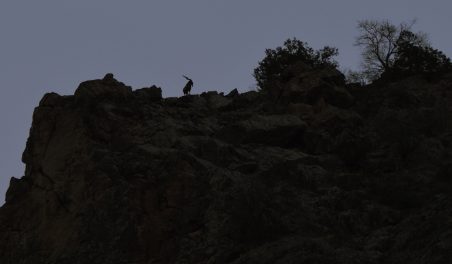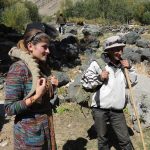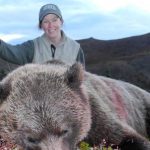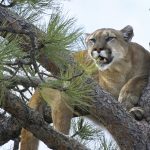Hunting wild sheep and goats in community-based game management areas in Tajikistan is a win-win for wildlife conservation and local livelihoods.
It’s early morning at the gorge of the Panj River in Tajikistan’s Darvaz Mountain Range; it is still dark and the foreign hunter has to climb a steep, rocky slope. He is assisted by guides of the Hunting and Conservation Alliance of Tajikistan (H&CAT), who know every stone. As dawn breaks, the spectacular mountains on the opposite side of the river appear. Their lower parts are covered by scattered woodlands of juniper, with small and very steep fields in between. Above are snow-covered peaks. Soon the local guides spot a group of more than a dozen screw-horned goats, females with kids from the last season, a few young males, and several mature males with long beards and very long corkscrew horns. But the old male, which had been spotted by the guides few days ago moving over the steep cliffs, is not among them. The guides scan the rocks with the spotting scope and suddenly see a shadow moving between the rocks–a snow leopard. Nearby, between the almond and Judas tree bushes, they see a pair of familiar-looking horns. The searched-for trophy markhor has already become the trophy of another hunter, the ghost of the Central Asian mountains.
During the next few days, the visiting hunter hikes many miles and climbs hundreds of feet. Finally he gets another markhor twelve years of age and with a horn length of almost 50 inches–a very old animal. Meanwhile, one of the rangers who protect this community-based game management area has been filming the snow leopard at its markhor kill. It turns out the big cat did not eat the huge markhor alone, but shared it with his mate. After having long been skeptical of snow leopards, seeing them as enemies and competitors, the managers of the conservancy now understand that the big cats and the markhor and ibex can all thrive at the same time. Although the occasional markhor or ibex is taken by predators, populations of the wild goats have grown and are healthy, structured with a good proportion of mature males. Increasingly these days, markhor are observed in the hillsides along the Panj river upstream from Zighar village, which long had been the border of their range.
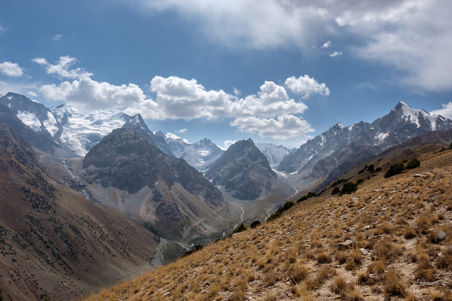
The mountains of Tajikistan are some of the most remote and beautiful in the world.
Population surveys by the Academy of Sciences of Tajikistan, together with government agencies and rangers of game management areas as well as independent scientists and NGOs, revealed that during the last few years markhor numbers have reached historic heights. At the end of the 1990s there were probably less than 350 Bukharan or Heptner’s markhor in Tajikistan; a survey in 2012 revealed that numbers were much higher, with more than 1,000 markhor recorded by the observers. In 2014 in a similar survey, 1,300 animals were observed, and during a partial survey in 2016 in key areas alone, close to 1,450 markhor were spotted. In February and March 2017, another survey took place involving participants from the Wild Sheep Foundation and the Caprinae Specialist Group of the International Union for Conservation of Nature (IUCN). The survey covered those areas of the markhor range in the country known to harbor most of the magnificent wild goats. The surveyors, after assessing and removing all possible repeated observations of the same animals, recorded 1,901 markhor in an area of 213 square miles. Among the recorded markhor, 78 of them were old males eight or more years of age that would qualify as huntable.
What is the background of this conservation success story? In the January/February 2017 issue of Sports Afield, Brad Fitzpatrick wrote about two markhor hunts in Tajikistan outfitted by Shikar Safaris. This article correctly states that the strong interest of big-game hunters has made the markhor an animal of great value to the local people and stimulates its conservation. However, there is a bit more to the story. In the first place, the local people, who stopped poaching and introduced effective protection of the markhor population, deserve the credit.
When I started to develop a project for community-based conservation of mountain ungulates in Tajikistan in 2007, the focus was on Asiatic ibex, a much lower-profile species with less controversy surrounding the hunting of it. Most ibex populations were down because of poaching and lack of any feeling of ownership by the local people. Similarly, Marco Polo sheep were rare or absent in substantial parts of their range, including the protected areas. On the other hand, some hunting concessions were obviously successful in keeping high populations of Marco Polo sheep, thanks to the income delivered by sport hunters. What I heard about the situation of the Bukharan markhor did not sound promising, however. The remaining animals were thought to be largely restricted to a protected area with immense security problems caused by its location along the border with Afghanistan, from where armed smugglers regularly intruded to kill markhor and urial. There were also reports about illegally organized trophy hunts, despite the species’ official protected status and listing under CITES Appendix I.
In 2008, the Mountain Ungulates Project was started with support from the German government and its development agency, Gesellschaft für Internationale Zusammenarbeit (GIZ) GmbH, as well as the Zoological Society for the Conservation of Species and Populations, a German nonprofit specializing in conservation of animal species often overlooked by the general public. In the Pamirs and its southwestern spurs, we met dozens of traditional hunters. These people were considered poachers by officials and most conservationists. We took another approach and recognized their traditions and interest. With our help and encouragement, several groups emerged and registered as legal entities, usually as non-commercial non-government organizations (NGOs). These people agreed not to poach, to protect wildlife, and to rehabilitate the game population, in the vague hope that future legal hunting opportunities would lead to income from hunting and nature tourism. Tajikistan’s government agencies in charge of wildlife assigned to these groups their traditional hunting grounds as game management areas.
By then, in the range areas of markhor, two families already had established small enterprises offering hunting trips for wild boars and Asiatic ibex, M-Sayod LLC and Morkhur LLC. During the next few years another small enterprise, Saidi Tagnob, emerged, as did a local NGO, Muhofiz, which unfortunately so far did not yet become an effective game management entity due to internal conflict and tensions in the local communities. The founders of these small businesses and their staffs were mostly informal hunters in the past. One of them once admitted that he had killed “hundreds” of markhor and never came back from the mountains empty-handed. These people know exactly how poachers access the areas and kill markhor, and they know how to prevent it. They also have a strong connection to “their” animals and they are excellent game scouts.
Regular wildlife surveys in the newly established community-based game management areas soon began to show increases in and stabilization of the populations of mountain ungulates–Asiatic ibex, Marco Polo sheep, and markhor. Now these areas host about 2,000 ibex, 500 Marco Polo sheep, 1,800 markhor, and 50 Bukhara urial, which is closely related to Afghan urial, with 200 more urial in new community-based conservancy areas under development. Hunts for ibex are available every year. In the 2013-14 season, the government by special decree issued the first hunting quota on Bukharan markhor in Tajikistan. Since then, the government, by annual decrees, has issued quotas of six or seven markhor per season.
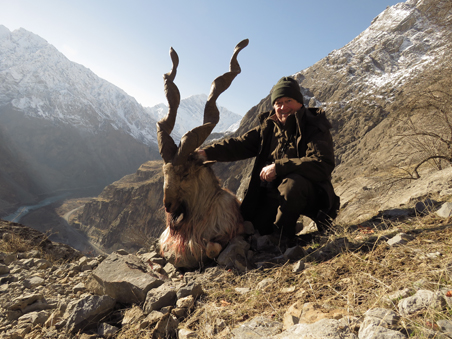
The markhor is one of the world’s most challenging game animals to hunt because the of the rugged country it calls home.
As a result of a roundtable of government agencies, scientists, NGOs, and game managers, organized with support by the German Government via GIZ, the first Marco Polo sheep quota was allocated to the local NGO Burgut this year. This community-based organization managed to rehabilitate the population of this magnificent sheep in an area close to Alichur village in the eastern Pamirs, where it was almost extirpated by poachers. As of this writing, two permits have been sold to American hunters. This will be the first argali hunting in a community-based conservancy ever, and will further boost the conservation efforts by the local traditional hunters and the support by the entire community in this remote mountain region.
Strong and healthy game populations, which offer great opportunities for hunters to experience a memorable hunt and to collect an exceptional trophy, are only possible where the local people protect the wildlife from poaching, regularly survey the status of the populations with involvement of outside experts, and do their best to preserve the entire ecosystem. This is achieved when local traditional hunters feel responsibility for the animal populations, get a substantial share of the money paid by the visiting hunters, and are at the same time accountable for the effectiveness of protection against poaching. Currently more than 150 rangers and more than 100 families directly benefit from income created by community-based game management in Tajikistan. Furthermore, all the other local community members need to see benefits from supporting wildlife conservation, game management and critical habitat, which sometimes comes at the expense of reduced grazing and fuel wood collection and some conflict with carnivores. The small enterprises M-Sayod, Morkhur, and Saidi-Tagnob in the markhor range areas, and the NGOs Parcham, Yoquti Darshay, Yuz Palang, and Burgut in the Pamirs, use the earned income for these purposes. They invest in conservation and in local community development, such as road repair, water supply, children’s education, and more.
Collectively, these organizations, with financial assistance and advice by the International Council for Game and Wildlife Conservation (CIC), have established the nonprofit Hunting and Conservation Alliance of Tajikistan (H&CAT) for joint marketing and contact with brokers and outfitters, for mutual assistance in logistics for hunting and other tourism, and for fundraising for and implementation of joint wildlife conservation and management activities. H&CAT also supports research in the conservancies. A Tajik Ph.D. student, who is studying “traditional ecological knowledge” in this context, was the recipient of the CIC Young Opinion Award in 2017.
Population trends, increasing trophy quality, satisfied sport hunters, income created, and livelihood improvements all add up to a success story for H&CAT, which the CIC in 2014 honored with its prestigious Markhor Award. However, there are also some critical challenges that the entities collaborating within the H&CAT struggle with.
The reputation of Tajikistan as a hunting destination is sometimes called into question by doubtful hunts organized by third parties. These can take the form of illegal offers, which are often difficult to identify as such; hunts in poorly managed areas with a high incidence of poaching and overhunting; and hunters being encouraged to shoot young animals, shoot at unrealistically long ranges, or engage in other unethical hunting practices. There are also rumors about staged hunts and manipulated trophies.
The high prices of hunts, especially markhor hunts, create a lot of interest by various actors to capture as much of the money spent by the hunter as possible. Often hunts are marketed by outfitters who rely on one or several intermediaries who take a substantial share of the money. Thus from a markhor hunt sold, $50,000 may be paid for the permit and logistics related expenses, a large amount may be taken by the broker and involved intermediaries, and less than half of the price of the hunt may actually reach the local small enterprise, which has to pay its rangers year-round and support its community. As the community-based conservancies get more experienced, many brokers, outfitters, and hunters are making direct contacts (facilitated by H&CAT) with the game area managers. This diversity of the market allows for an optimum share of the revenues to reach the local level. On the other hand, there are also intermediaries, which may not contribute to the conservation management of game and its habitats or to local development, but are only interested in quick profit.
Hunts of doubtful scientific justification and legal basis, unethical practices, capture of high shares of hunting revenues by outsiders, attempts to monopolize quotas and take over game management areas–all of these can put at risk the achievements that have been made in wildlife conservation and in the welfare of local communities. This can result in the good managers losing motivation and opportunities for action; and poaching may again become rampant and lead to a fast decline of the just-rehabilitated populations of markhor and other game. Such a situation would hurt hunters first, as they would experience unsatisfying hunting trips with no success, and later might be confronted by bans on hunting and trophy import to their home countries. The seriousness of the latter risk is shown by the recent trophy transportation boycotts by airlines, and by the import restrictions and bans by the US, European Union countries, and Australia on species like lions, elephants, hippos, polar bears, and more. Such a ban on markhor would not only harm hunters and the hunting industry, but would risk the end of this conservation hunting success story.
It is in the hands of hunters, brokers, and outfitters to prevent the bleak scenario described above and to ensure the sustainability of markhor and other mountain ungulates conservation and hunting in Tajikistan. One important part is to avoid unnecessary and costly intermediaries. The community-based conservancies can be contacted via the Hunting and Conservation Alliance (H&CAT, [email protected]), which acts as their joint contact, communicates in English, and takes care of all aspects of the preparation and conduction of the hunt, including all permits, logistics in the country, and assistance with trophy shipping. If you prefer booking via your broker, ask him in what game management area the hunt will take place and if he is in direct contact with H&CAT and/or its partners.
While hunting, you should care about the ethics of hunting. Often local guides feel strong pressure and may encourage hunters to take too young animals or to try risky shots. Hunting should be about the whole experience, but also about the contribution to the conservation of these magnificent creatures and the support of local communities. There can never be a 100 percent guarantee of taking the desired trophy, as some brokers may promise; hunting of free-ranging animals, not farm-raised ones, always includes some uncertainty, and this is a crucial part of the hunt. Trophy hunting should not necessarily target the most beautiful and largest animal, but the oldest one, an animal that has had the opportunity to pass his genes to the next generation. Its horn tips might be broomed or broken, thus being possibly an inch or so shorter than those of another one at the full height of breeding age. Current trophy scoring systems tend to undervalue such old animals and give higher scores to animals that are at the height of their reproductive potential. The best hunters know that it is not the highest score that matters, but the fact that you helped to preserve a healthy and genetically fit population. Never accept any offers to take another, “better,” trophy, as this can trigger killing beyond the quota, and possibly even creation of artificial trophies from animals shot earlier, sometimes bought from local poachers–all with negative impact on the status of the population and the reputation of trophy hunting.
Only responsible hunters can ensure that the incredible experience of hunting in Tajikistan’s mountains will be possible in the future and that markhor, ibex, urial, and argali can thrive together with snow leopards and other wildlife and benefit the rural people of this beautiful region.
Editor’s note: Stefan Michel is a biologist from Germany who has worked in Central Asia since 1993. Since 2008, Stefan, supported by the German development cooperation agency GIZ, has worked in Tajikistan and facilitated the development of sustainable, community-based conservation and management of wild mountain ungulates. He is a member of the IUCN Species Survival Commission Caprinae Specialist Group and affiliated with the NGOs Nature and Biodiversity Conservation Union Germany (NABU) and the Zoological Society for the Conservation of Species and Populations.

